Labor and Delivery Internal Analysis
- Strengths:
- L&D’s performance;
- Difficult deliveries;
- An extensive number of health-related offerings;
- Modern wards;
- Weaknesses:
- Patient feedback;
- Industry requirements;
- Availability of information regarding this L&D department online;
- Information technology services.
Power SWOT model program was applied for this analysis because it allows identifying the elements of the internal and external environment that affect St. Anthony’s performance in regards to both internal and external components. The following table presents an assessment of internal components that impact the outcomes of this L&D’s work.
Firstly, the quality of performance and patient outcomes are the top priority for this hospital, which is reflected in the Nursing Excellence Reward and the existing certification. St. Anthony’s L&D is equipped and has medical professionals that can take care of complex delivery cases, which is a competitive advantage. Current service line includes a variety of health-related services including post-delivery care and an in-hospital neonatal unit for prematurely born babies. The existing facilities at St. Anthony’s correspond to customers’ expectations because they were recently renovated and allow family members to stay with mothers in their suites.
Next, in regards to weaknesses, it can be argued that current scorecard metrics lack details and require improvements; for instance, customer satisfaction is a crucial performance indicator and currently is at 82%. The current market demands provision of additional services at L&D centers, for example, mothers want to receive manicures or pedicures, which are unavailable at St. Anthony’s at present. Online presence, such as profiles on popular social media platforms, professional website with additional services, and a good review score at Yelp, of this hospital, is limited, which affects the decision-making process of prospective patients. Other services such as mobile applications for tracking nutrition or pregnancy details and an on-site video footage of delivery that clients may be interested in are unavailable.
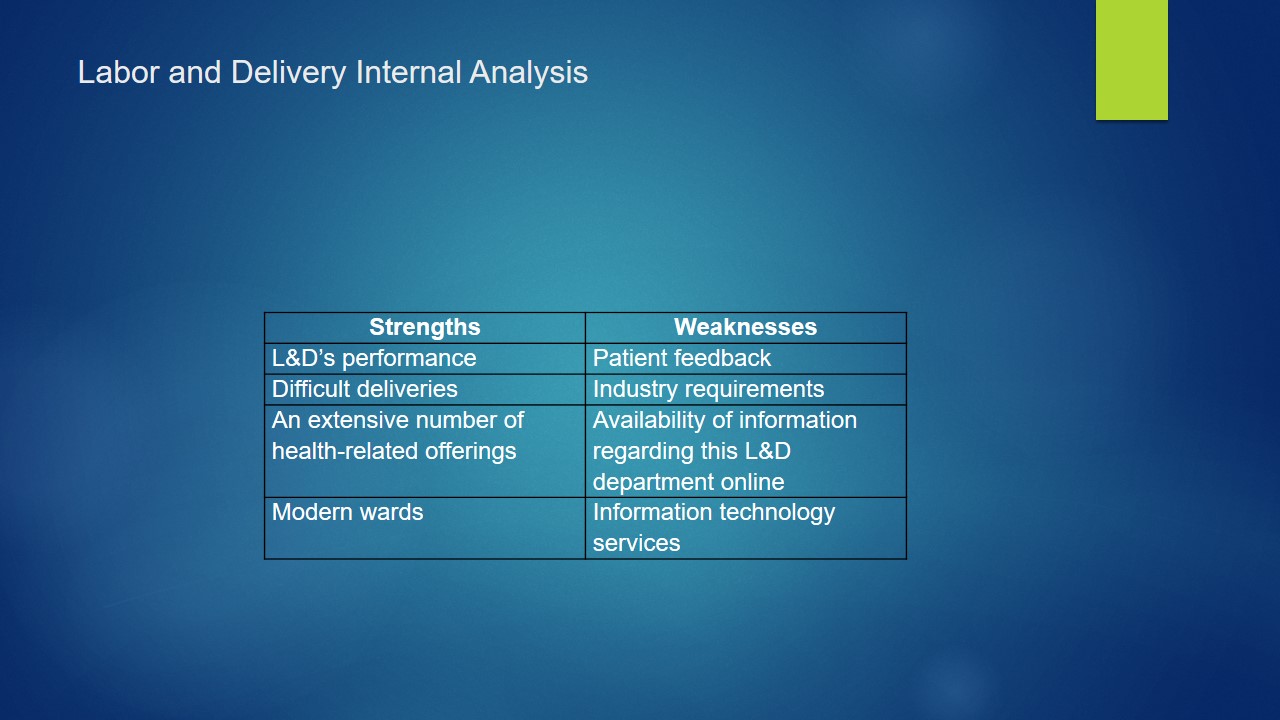
External Analysis
- Opportunities:
- Technological solutions help attract patients;
- Cultural diversity as a defining factor of the decision-making process;
- Client preferences change towards family-friendly facilities;
- Number of pregnancies and deliveries continues to grow;
- Threats:
- St. Anthony’s competition is actively using additional marketing channels;
- Other hospitals already offer non-medical procedures to their patients;
- Medicaid patients make decisions based on the final cost of the delivery;
- Lack of strategic orientation towards applying information technology.
Firstly, Application of technology in L&D facilities is becoming increasingly important and provides an opportunity for acquiring a significant competitive advantage over others. Secondly, for a large group of clients, it is crucial to understand that their chosen hospital can offer services tailored to different cultures. For instance, having an on-demand translator for languages prevalent in the US such as Chinese or Spanish presents an opportunity to attract a different segment of this market. Thirdly, patients nowadays prefer to be accompanied by close family members during their stay at the labor and delivery, which helps present St. Anthony’s facilities to a larger group of people who can later become its patients. Finally, in recent years, the US experiences a steady increase in the number of births, which indicates a possibility to grow within this segment of healthcare and retain more profit.
The threats that St. Anthony’s Labor and Delivery faces are significant as well. The primary competitors in this area use a variety of marketing communication channels, such as social media platforms or offline events to introduce their services to prospective patients, which allows them to attain more deliveries. Additionally, they provide manicures, pedicures, or massages on site to mothers staying at their facilities. Another critical element is the inability to attract a sufficient number of individuals who use Medicaid because of high costs. Finally, this L&D does not have a strategy that would allow using the current demand for health-related mobile applications to attract new clients.
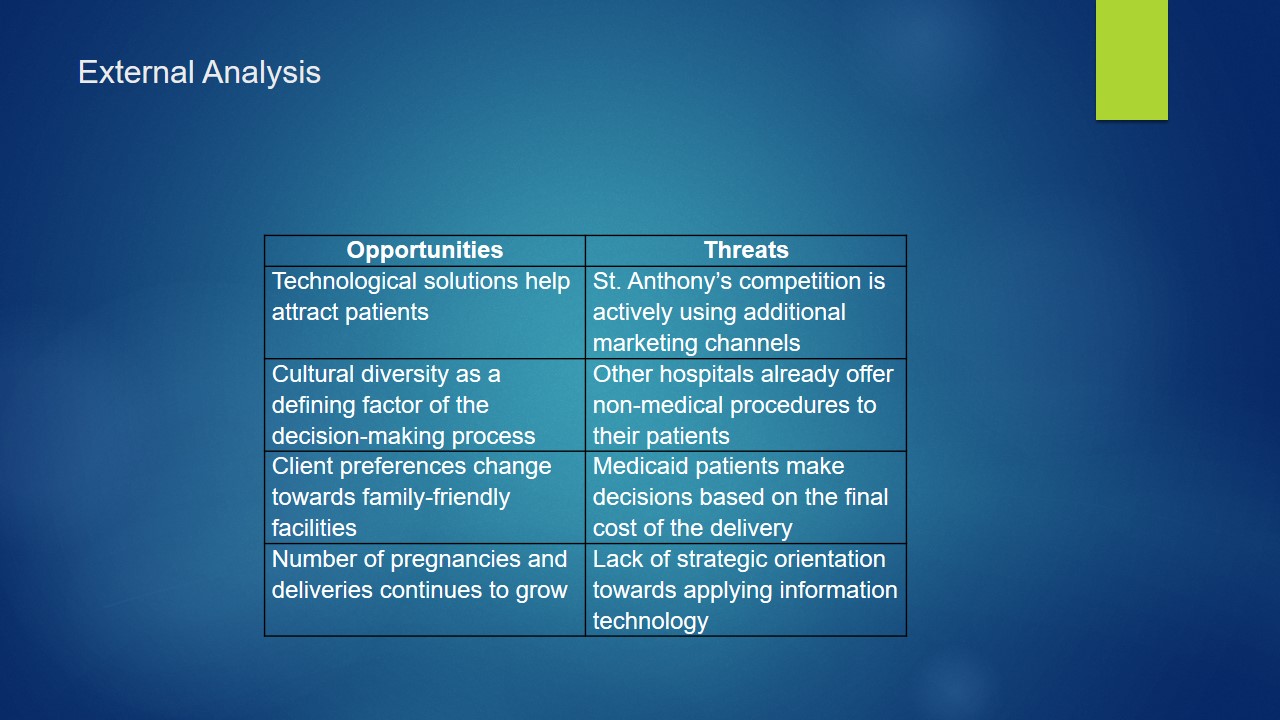
Criteria for Evaluation
- The following criteria should be used to evaluate this analysis:
- Identification of internal components that affect customers;
- Competitor’s activity that allows them to have an advantage over St. Anthony’s;
- Importance of each factor to the company’s performance;
- Competency of the marketing team that is responsible for the analysis.
A proper marketing strategy should consider not only particular assumptions but provide factors based on which the policy was created. According to Rohm (2012), to develop an appropriate strategic management plan for an organization one has to not only look at what target should be achieved but also at what may affect the process. This allows evaluating all components that will change the outcomes of the plan. For this market examination, the primary goal is to obtain a clear understanding of the current situation at St. Antony’s L&D, including the financial data, services, and quality that impacts health outcomes of patients. Moreover, one should examine the competitors of St. Anthony and define the missing approaches that can help this L&D attract more patients to its facilities to identify which changes should be made to the existing service line. Haile and Krupka (2016) state that while the SWOT analysis that was presented allows assessing the factors that impact performance, it is necessary to evaluate their importance the overall result of operations. Therefore, each should have a percentage of weight in regards to the final objective. Based on this information, it can be argued that the presented analysis considers all internal and external factors that impact the performance of St. Anthony’s. According to Rohm (2012), strategic plans should identify a value proposition for clients, results, objectives, and maps. These components will be reviewed in the following sections of this marketing plan presentation.
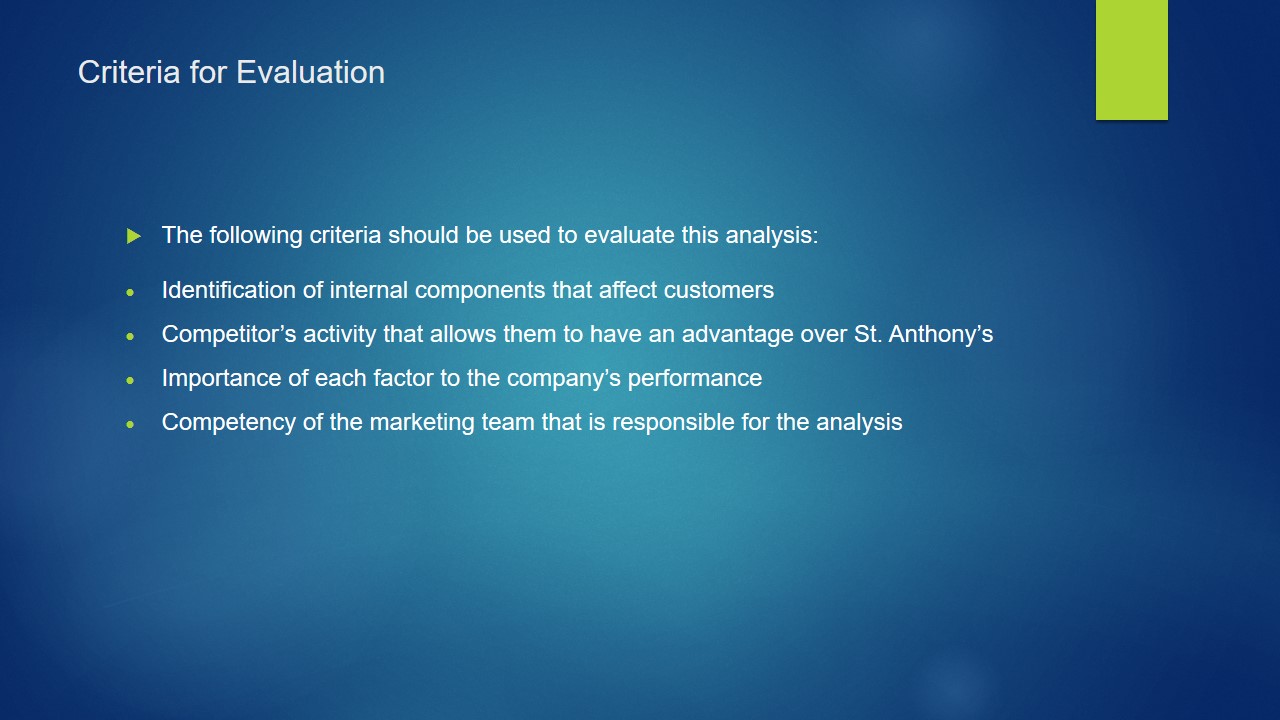
Gap Analysis
- Actual:
- Financial losses to the hospital due to inadequate revenue from operations;
- Small market share in the L&D industry;
- Inability to provide St. Anthony’s with more prospective patients that would be familiar with the establishment’s performance;
- Desired:
- Break Even;
- Increase in the number of deliveries by 10%;
- Additional services as per market demands;
- Market share increase within 4%;
- The attraction of patients that can take advantage of other St. Anthony’s capabilities (for instance family care).
In terms of profit, the current goal is to reach a break event point, meaning that the strategy should attract enough customers to ensure that the costs hat St. Anthony’s Hospital spends on providing that this L&D operates daily are covered by revenue.
For the hospital to reach the desired result, the number of deliveries that occur in the facility has to increase by 10%. This will allow obtaining a profit necessary to pay for the marketing expenses, which will be discussed in detail in the cost and benefit analysis section of this presentation.
Additionally, increasing the number of deliveries that occur at this L&D will help St. Anthony improve its market share. The company has to improve the value proposition and offer additional services, as well as communicate the new strategy to its customers to reach the objectives.
The market share that St. Anthony’s L&D has should be increased within the next five years. This approach will allow the L&D unit to strengthen its position in the industry and become a leader in this market.
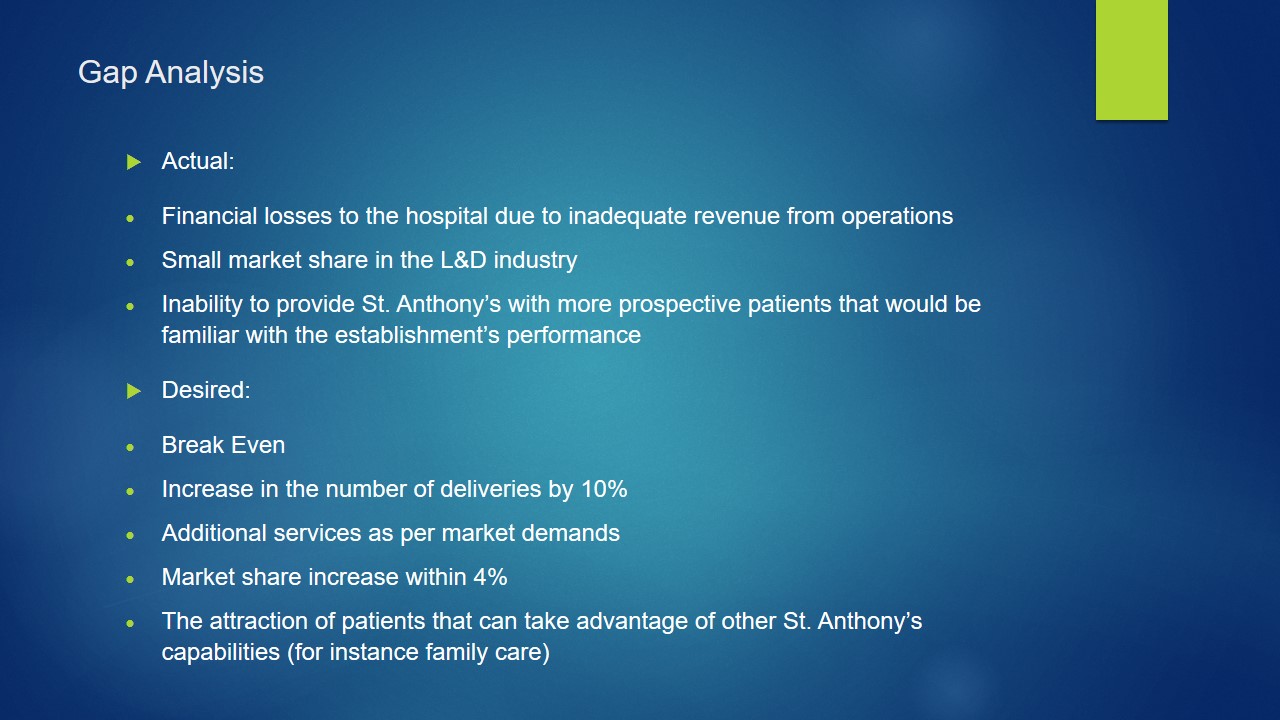
Areas of Uncertainty and Certainty
- The information that can help improve this analysis and create a better understanding of the current L&D market is:
- The total assessment of the number of deliveries and costs;
- Number of patients that use Medicaid;
- Current return on investment ratio will provide an understanding of the efficiency of the existing marketing channels;
- This information was used in the analysis:
- St. Anthony’s competitors assessment;
- Service line;
- Focus group interview.
Currently, the marketing strategy is based on the knowledge of St. Anthony’s service line, its quality, particular metrics that allow evaluating customer experience, a brief assessment of the focus group, and analysis of competitors’ offerings. However, to create a financially efficient marketing strategy it is necessary to examine some of the strategic numbers that can help understand how the current resources are allocated and what factors helped mothers choose St. Anthony’s L&D as their provider. This will help improve the plan and locate better strategic solutions. Rohm (2012) states that this information can be used to create a strategy map, which is a value proposition for customers and other stakeholders. The result of this approach is enhanced performance and maintain focus on the desired target.
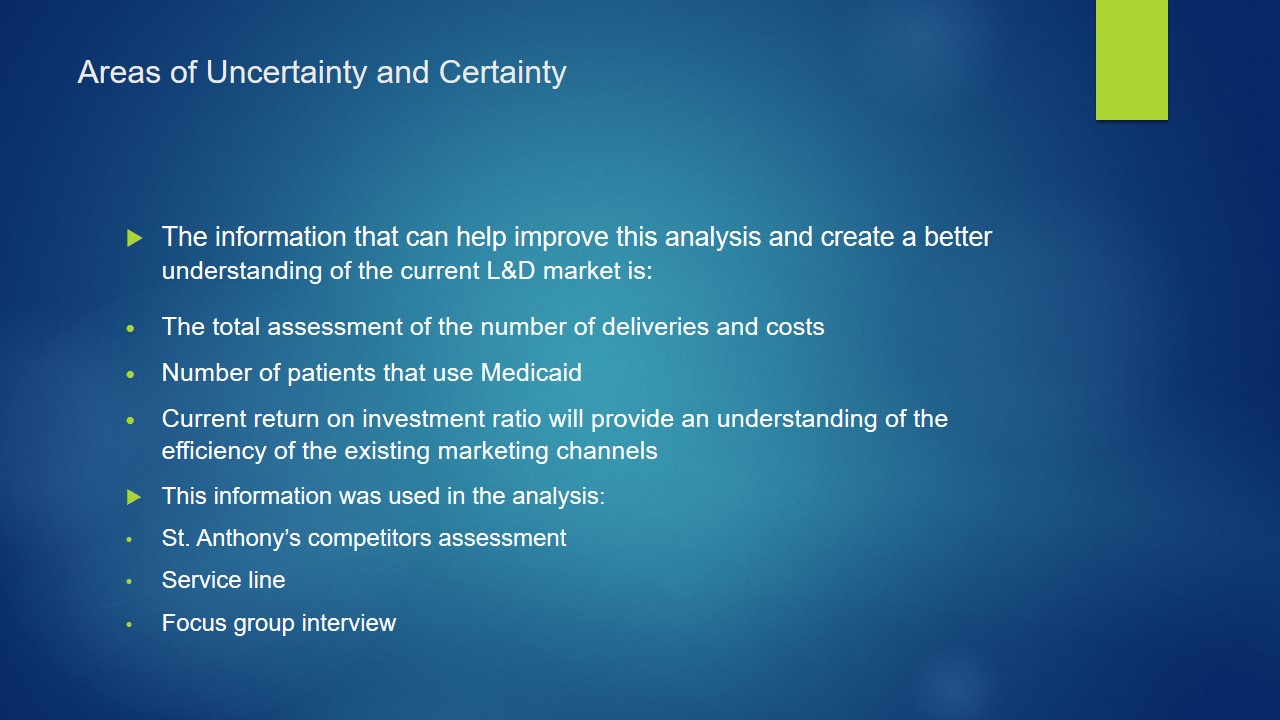
Marketing Communication Strategy
Market segments for St. Anthony’s L&D:
- Married women from 30 to 50 years old with above-average earnings.
- Unmarried women from 20 to 30 years old and teenagers 15 years old and above with average and above average income.
- Culturally diverse populations and same-sex couples.
Based on the located information three primary market segments were determined based on age, income, and interests. The first group would be interested in manicures and pedicures due to the fact that they imply extra comfort during the hospital stay. Therefore, it is vital to utilize social media and a professional website to communicate this approach to them. The second segment may be more interested in the cost of staying in the L&D because their income is below average. It can be assumed that they would take advantage of a governmental program such as Medicaid; thus, this population would be interested in receiving additional services that would not require payment because each of this features would have to be covered by out of pocket payments. Culturally diverse populations and same-sex couples require information about the offerings of St. Anthony that cater to their needs. For instance, as was previously discussed, they may want to find out about the possibility of hiring a translator or about in vitro fertilization that the medical establishment provides. From this perspective, a website that has all the necessary information would present benefits to this segment. The assumptions regarding market segments and additional information about these people were made based on the statistics provided by the Census Reporter and the US Bureau of Statistics in the area (“Minneapolis-St. Paul-Bloomington,” 2017). Each market segment will attain additional benefit from these offerings and communication channels that St. Anthony’s would apply, which should improve the amount of individuals choosing this hospital.
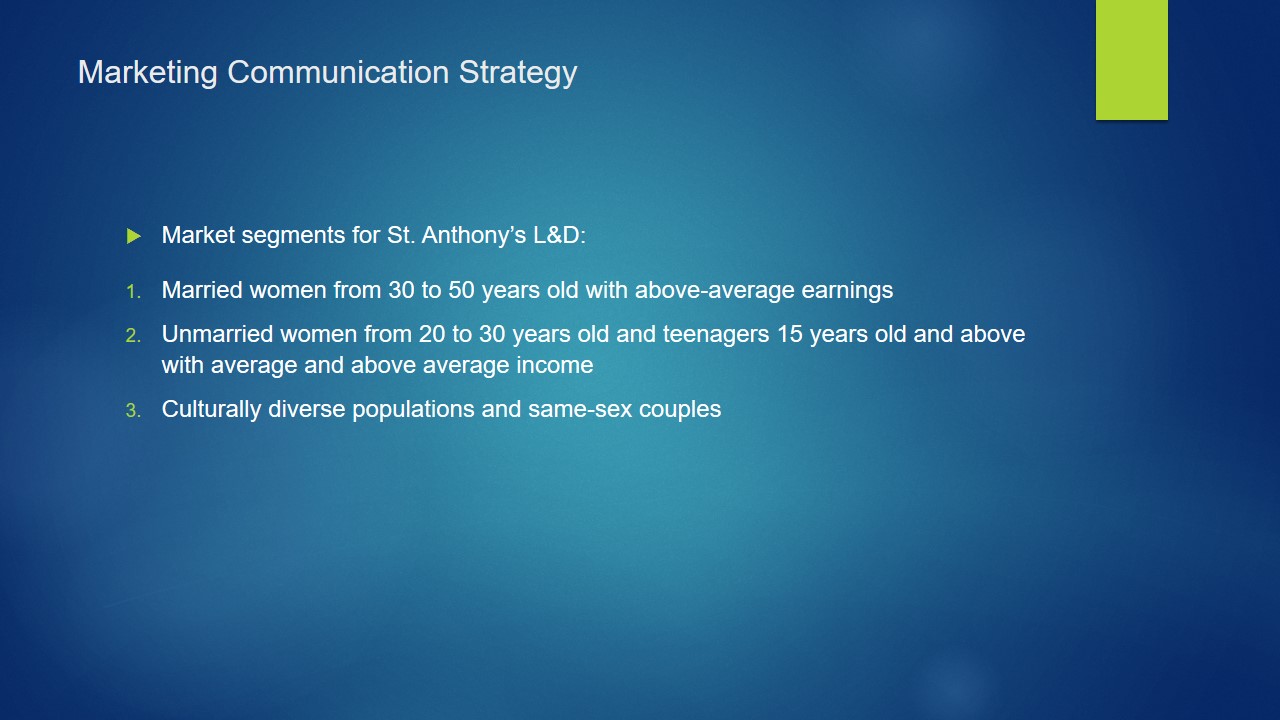
Marketing Communication Strategy and Assumptions
- Main Communication channels:
- Social media (primarily Instagram and Facebook);
- Website;
- Free of charge educational courses for prospective mothers;
- The action plan, in this case, includes the following:
- Identify an onsite professional who will be responsible for social media content form the marketing department;
- Locate freelance professionals, for example, photographers and videographers;
- Hire professionals that will be delivering manicure and pedicure services and examine the market of freelance translators that would provide services to the culturally diverse populations;
- Identify a medical professional that will be teaching the educational course for mothers;
- Create an evaluation that would help measure the outcomes of each approach.
The associated costs are presented in the cost and benefit analysis and involve primarily expenses associated with hiring freelance professionals and internal specialists that would be responsible for each channel.
Communication strategy is based on the recommendation from Fernández-Luque and Bau (2015). Modern users rely heavily on the Internet when making most of the critical decisions, thus, St. Anthony should assume that prospective mothers from each of the three segments would use online resources to locate information about hospitals in the area and compare prices and services. To leverage this channel St. Anthony would have to focus on creating a content plan and updating content regularly, as well as communicating with users online by answering their questions and addressing concerns.
Thus, the conceptual level approach recommendations apply the assumption that all three identified market segments use social media when researching information about a particular healthcare establishment and the nature and quantity of this data, as well feedback from other patients affects their choices. This is substantiated by Debra (2011) who argues that factual information is not as essential as emotions in regards to decision making. Therefore, the focus of this strategy should be on creating a positive perception of St. Anthony’s and on a connection with patients.
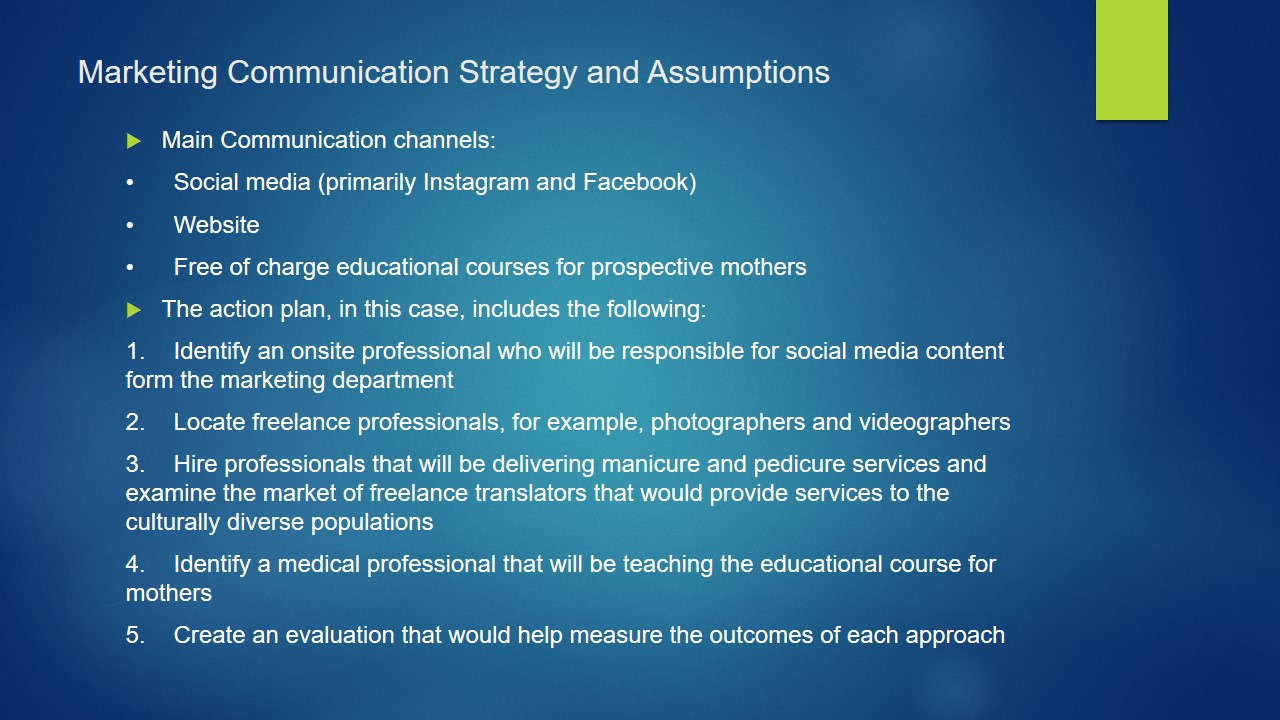
Cost and Benefit Analysis
10,000 budget
- Spending’s – $5172;
- Benefits – $130,239;
The current cost and benefit analysis considers the investment of $10,000 and its evaluation as opposed to the benefit that it would bring throughout five years. This plan recognizes the fact that St Anthony already has a valid strategy for attracting consumers; therefore, not all of the money dedicated to this plan. This helps lower the risks and test the chosen approach to define the most cost-effective method for attracting patients.
-10% budget
- Spending’s – $4172;
- Benefits – $130,239;
When considering a smaller investment of $9,000, it can be concluded that St. Anthony’s will be able to carry out the proposed strategy as it requires only $5172 and leaves additional funds for the marketing approaches that this hospital is already using. However, in case it is necessary to limit the spending on this strategy, the hospital can lessen the number of work hours for a freelance specialist and in this way reducing the expenditure. The rationale for this choice is that the existing marketing professionals would be able to create content with limited help from photographers and videographers.
+10% budget
- Spending’s – $6172;
- Benefits – $130,239.
In case St. Anthony’s executives decide to provide a larger investment of $1100 for the implementation of this plan, the marketing team will be able to take advantage of the entire sum and offer more online and offline classes, more content on social media, and expend the service line offering even further. The rationale that underlines this cost and benefit examination is the comparison of the hourly wages of onsite professionals and freelance fees as well as assumed timeframe required to fulfill the needs of St. Anthony’s Medical Center.

ROI and Recommendations
- Financial recommendations:
- Examine the net income from each delivery to calculate ROI;
- Test the chosen strategy and define the number of actual clients that these channels can provide;
- Determine what specific budget should be allocated for this strategy;
- Criteria for evaluating ROI:
- Do the net earnings from this strategy exceed the anticipated spending?
It is necessary to evaluate the return on investment (ROI) for the chosen marketing strategy because St. Anthony will have to allocate funds to ensure proper Implementation of this plan. As can be seen from the cost and benefit analysis, the hospital can have an additional income of $130,239 a year. It is necessary to obtain information regarding the expenses of the hospital for this period. to calculate ROI. However, the current assumption is that the establishment will be able to receive profit by applying this approach. Overall, recommendations for St. Anthony include taking advantage of the proposed marketing strategy and applying the three communication channels to attract new prospective mothers. In addition, the hospital should measure the outcomes after the first month of implementation and in each following month to determine the efficiency of each channel. In case the strategy is valid, St. Anthony should allocate more funds towards this plan by providing an additional 10%, which would allow having extra free of charge lessons for mothers.
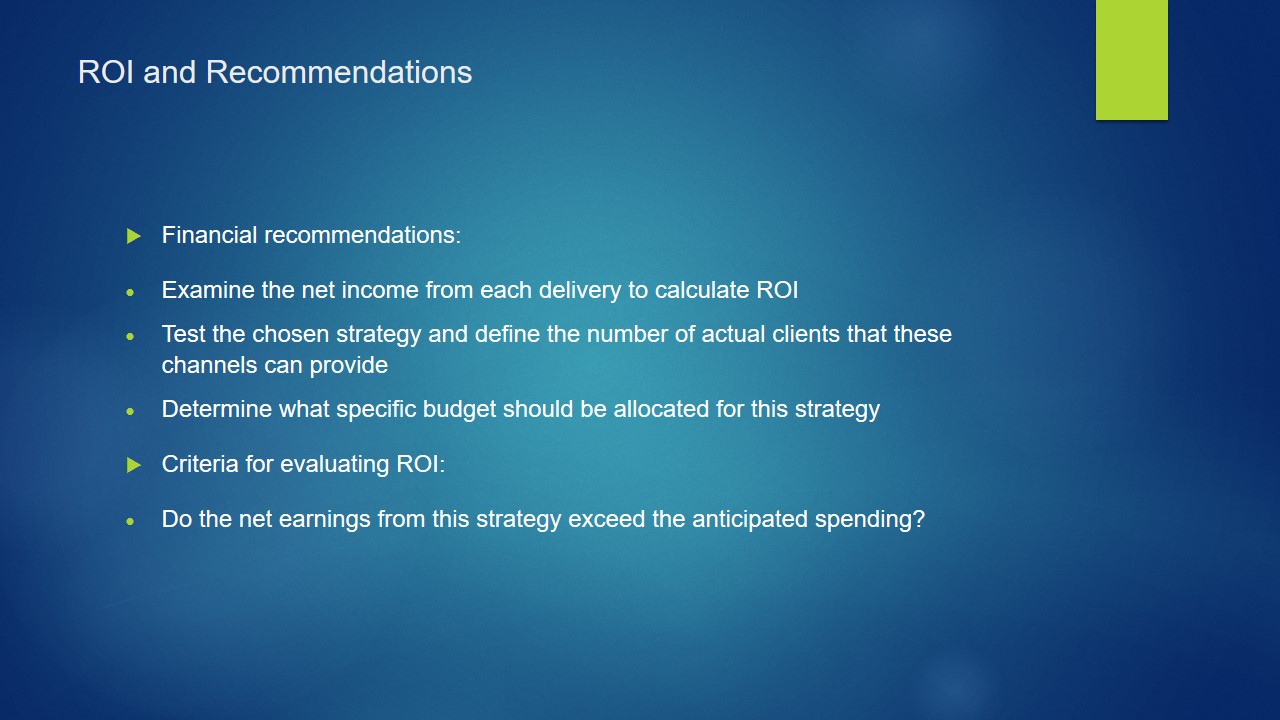
Addendum Project Implementation Timeline
The leader of this Project: Richard Holmes.
Project Timeline
- March 1st – March 15th – Defining roles for each of the communication channel and task.
- March 15th – April 15th – Creating execution plans, including content strategy and lesson plans.
- April 15th – April 20th – Allocating resources, for instance, financials, photos, and videos, a place for lessons.
- April 20th – November 20th – Testing each strategy.
- November 20th – March 1st – Implementing changes using feedback assessed during the previous stage and allocating financial resources towards strategies that demonstrate outstanding efficiency.
The timeline proposed above is a brief one year plan that includes all activities and evaluation criteria necessary to carry out this marketing strategy. The assumption on which this plan is based is that the project may have to be altered due to unpredicted circumstances, thus, the first stage involves testing the chosen communication channels. From November 20th the marketing team will be able to implement the final adjustments.
Performance Measures for each stage are:
- Does each strategy have a professional who will be responsible for its implementation?
- Is there a 12-month plan that would guide the educational program and social media professional
- Do people responsible for each channel have the necessary funds and on-site resources to perform the plan?
- Did the number of patients in this L&D increase since the new approach was implemented? Do patients who choose this L&D unit to cite any of the selected channels as crucial in their decision-making process?
- Does this plan result in an more patients choosing St. Anthony’s L&D?
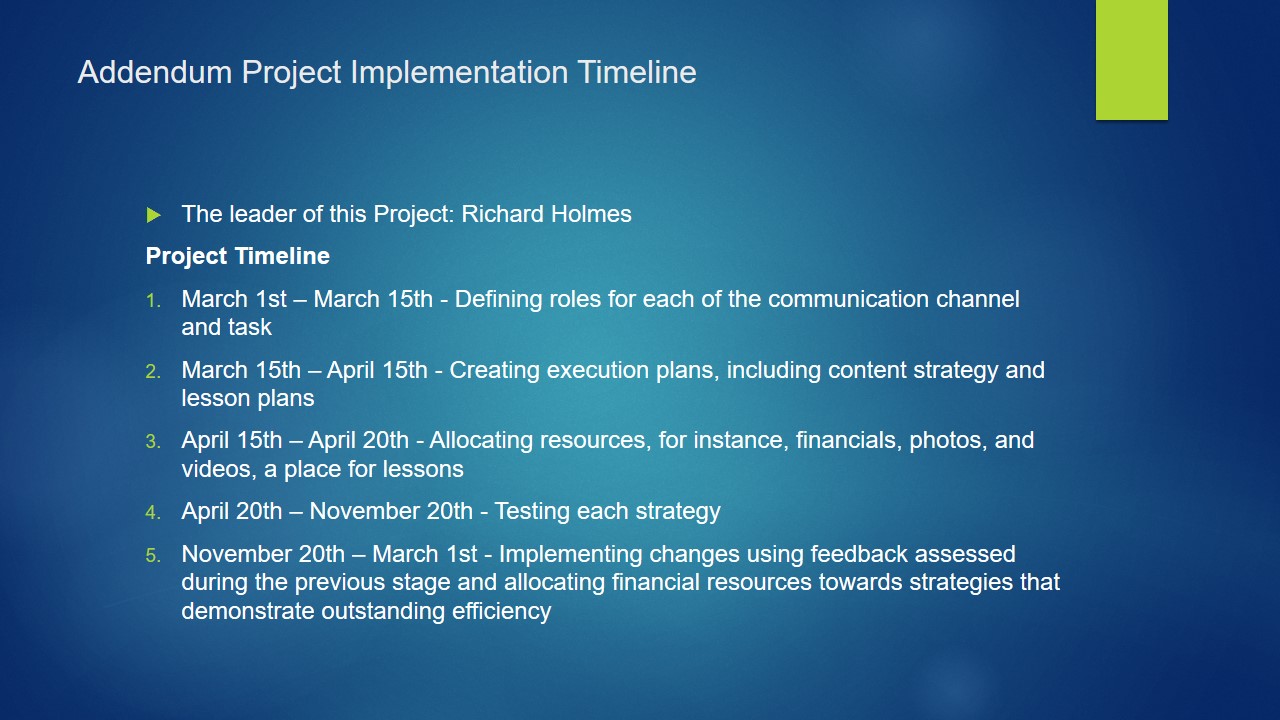
References
Debra, C. (2011). Steps to growing your practice: What works and what doesn’t – marketing plan 2012. The Journal of Medical Practice Management, 27(3), 140-143.
Haile, M., & Krupka, J. (2016). Fuzzy evaluation of SWOT analysis. International Journal of Supply Chain Management, 5(3), 172-179.
Fernández-Luque. L., & Bau, T. (2015). Health and social media: Perfect storm of information. Healthcare Informatics Research, 21(2), 67-73. Web.
Rohm, H. (2012). Make performance improvement strategic. Web.
Minneapolis-St. Paul-Bloomington, MN-WI metro area. (2017). Web.